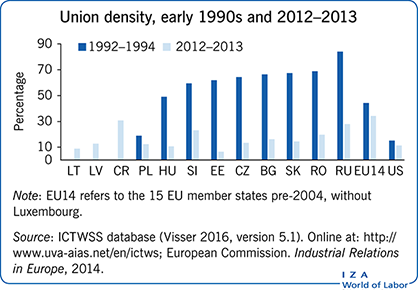Elevator pitch
Countries with strong industrial relations institutions and well-established social dialogue often perform well in terms of economic growth and social cohesion. The weak and fragmented bargaining and low levels of union coverage in Central and Eastern Europe (CEE) raise concerns about these countries’ potential to maintain competitiveness, tackle demographic and macroeconomic challenges, and catch up with Western European economic and social standards. There is evidence that unions in CEE continue to protect their members and generate wage premiums, despite their institutional weaknesses.

Key findings
Pros
Collective bargaining in CEE is associated with higher wages, in particular among medium- and high-skilled workers.
Trade unions in post-socialist countries were effective in protecting their members during the 2008–2009 economic crisis.
The process of EU integration strengthened the social dialogue and the role of the remaining trade unions in many CEE countries.
The increase in non-standard work may represent an opportunity for trade unions to strengthen their role and improve perceptions of unions among employees.
Cons
Trade unions in CEE countries are weak and fragmented following a sharp decline in unionization during the period of economic transition.
Collective bargaining coverage is low, taking place predominantly at the firm level and in the public sector.
The increase in non-standard employment, which is rarely unionized, is further lowering unions’ coverage and bargaining power.
CEE countries have diverse models of industrial relations, while the evidence regarding countries outside the EU is scarce.